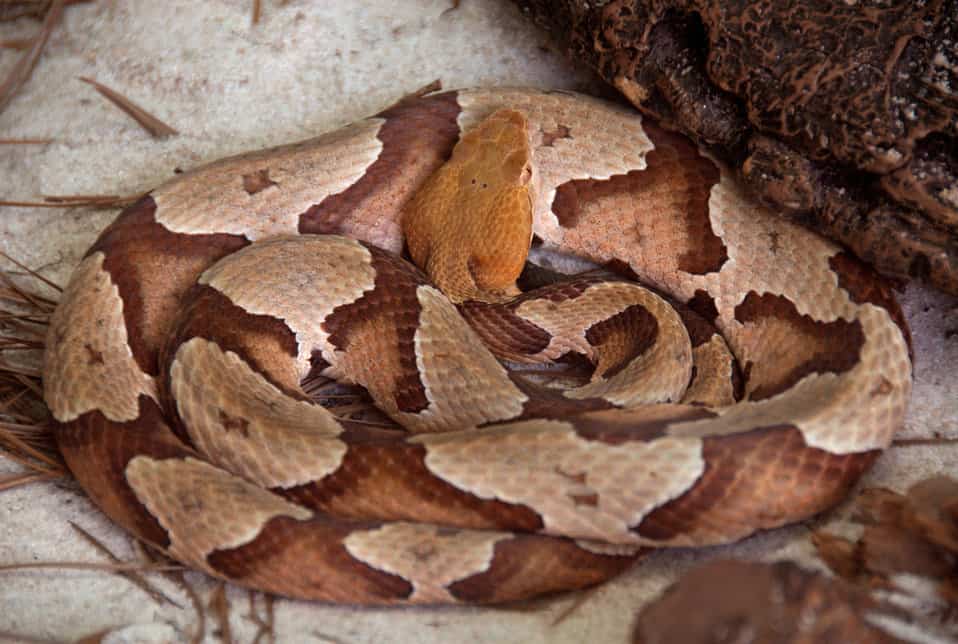Happy Trails and Safe Tales: A Parent’s Guide to Copperhead Snake Species
Hey there, awesome parents! Are you ready to embark on a journey to understand and respect our slithery neighbors, the copperhead snakes? Fear not, for this guide is going to be your trusty companion in fostering safety, awareness, and maybe even a bit of admiration for these often misunderstood creatures. Grab a comfy seat, and let’s dive into the fascinating world of copperheads, with a sprinkle of fun and a dash of knowledge!
Meet the Copperheads: A Quick Overview
First things first, it’s important to know who we’re talking about. Copperhead snakes (Agkistrodon contortrix) are one of the most common venomous snakes found in North America. Known for their distinctive coppery-brown head and beautifully patterned bodies, which allow them to blend into their surroundings with ease, copperheads have a certain rustic charm. But as much as we appreciate their beauty from a safe distance, it’s vital to understand how to coexist with them safely, especially when exploring the outdoors with your little adventurers!
Where Do Copperheads Hang Out? Understanding Their Habitat
Copperheads can be quite the homebodies, having a fondness for certain types of habitats. They love wooded areas, rocky landscapes, and often enjoy sunbathing on stones or in clearings. Knowing where these snakes like to chill is step one in avoiding unwanted encounters. So, whether you’re planning a forest hike, a picnic near a rocky area, or some backyard exploration, it’s essential to be aware of these hangouts to keep your family safe.
Copperhead Behavior: What to Look Out for
Kids are curious by nature, and that’s fantastic! But when it comes to being outdoors among wildlife, including copperheads, it’s crucial to encourage safe and respectful exploration. Copperheads, for instance, are generally docile and prefer to avoid confrontation. However, they will defend themselves if they feel threatened. So, let’s instill in our kiddos the importance of observing nature with their eyes and not their hands, keeping a lookout for these snakes that might just be minding their own business.
A Seasonal Perspective: When Are You Most Likely to Encounter a Copperhead?
Understanding the seasons can greatly reduce the chances of a surprise copperhead meet-and-greet. These snakes are most active in the warmer months, particularly from late April through early October. It’s during these times that they’re on the move, searching for food or a mate. Be extra vigilant during spring and fall, especially at dawn and dusk when they’re most likely to be out and about.
The Importance of Educating Your Children About Snakes
Knowledge is the best defense against fear and accidents. Teaching your children about copperhead snakes — what they look like, where they live, and what to do if they see one — is incredibly empowering. It not only helps keep them safe but fosters a respect for nature and its inhabitants. We’ll cover some fun and engaging ways to educate your children about these snakes without spooking them in the up-and-coming sections of this guide.
What to Do If You See a Copperhead: Safety Tips for the Whole Family
Encountering a snake in the wild can be a startle, but there’s no need to panic! We’ll go through some clear and simple steps to take if you or your family spots a copperhead during your outdoor excursions. Remaining calm, slowly backing away, and keeping a good distance are just a teaser of the tips we’ll discuss in more detail.
Alright, super parents, we’re just getting started! Stick with me as we continue to unravel the mysteries of copperhead snakes and learn how to navigate our wonderful natural world with both confidence and wonder. Because after all, the more you know, the more enjoyable and safe your outdoor family adventures will be!

Five Crucial Things Parents Should Know About Preparing for Copperhead Snakes
- Identify Them Correctly: Copperhead snakes are distinguishable by their copper-red heads, hourglass-shaped bands on their body, and a length of commonly 2 to 3 feet. Their pattern helps them camouflage in the fallen leaves. Familiarize yourself and your children with what a copperhead snake looks like through pictures and guidebooks. This knowledge will help you avoid mistaking a non-venomous snake for a copperhead and vice versa.
- Prevention is Key: When in an area known for copperheads, wear closed-toe shoes and long pants when walking through leaf litter or near rocks. Keep your yard trimmed and tidy to reduce the hiding spots for snakes. Always use a flashlight after dark as copperheads are nocturnal.
- Snake-Proof Your Outings: Stay on well-trodden paths when hiking and never reach into a place where you cannot see, like densely leafy areas or piles of rocks. Teach children to stay close and to alert an adult if they spot a snake,without approaching it.
- First Aid Knowledge: While copperhead bites are rarely fatal to humans, it is important to know the basics of snake bite first aid. This includes remaining calm, immobilizing the bitten area, and seeking medical attention immediately. Do not attempt to suck out venom or apply a tourniquet. Instead, focus on keeping the affected limb at heart level and getting to a hospital as quickly as possible.
- Interactive Learning: Engage your children in learning about copperheads through educational games, nature documentaries, and visits to local natural history museums. These activities reinforce their ability to recognize and respect copperhead snakes, turning fear into fascination with appropriate caution.
Prevention Tips: Creating a Snake-Smart Backyard
Ensuring your backyard is less attractive to copperheads is a proactive way to protect your family. Remove potential snake shelters like piles of wood, rocks, and dense brush. Also, consider installing a snake-proof fence that is flush to the ground, at least 30 inches high, and angled outward.
The Big No-Nos: Common Myths and Mistakes to Avoid
There are many myths out there about deterring or handling snakes. For instance, mothballs and over-the-counter snake repellents have not been proven to work and can be harmful to children and pets. Also, trying to kill a snake is typically what leads to most bites, so it’s best to leave the snake alone and move away.
Seeking Professional Advice: When to Call in the Experts
If you frequently encounter snakes in your yard or have spotted a copperhead, it may be time to call a wildlife professional. They can safely remove the snake and offer advice on how to make your property less inviting to them in the future.
Remember, while encountering a copperhead snake can be a nerve-wracking experience, it can also serve as a wonderful opportunity to teach your children about wildlife, habitats, and the importance of coexisting with nature. By learning together and taking the proper precautions, your family can enjoy the great outdoors safely and harmoniously.
We hope this guide has eased any worries and prepared you for your next family adventure under the sun, amidst the trees, and in the company of our planet’s remarkable wildlife. Continue to explore and cherish these moments of discovery with your little ones, equipped with the newfound knowledge and confidence to navigate the presence of copperhead snakes.
For more great fun click here. For more information see here
Disclaimer
The articles available via our website provide general information only and we strongly urge readers to exercise caution and conduct their own thorough research and fact-checking. The information presented should not be taken as absolute truth, and, to the maximum extent permitted by law, we will not be held liable for any inaccuracies or errors in the content. It is essential for individuals to independently verify and validate the information before making any decisions or taking any actions based on the articles.




